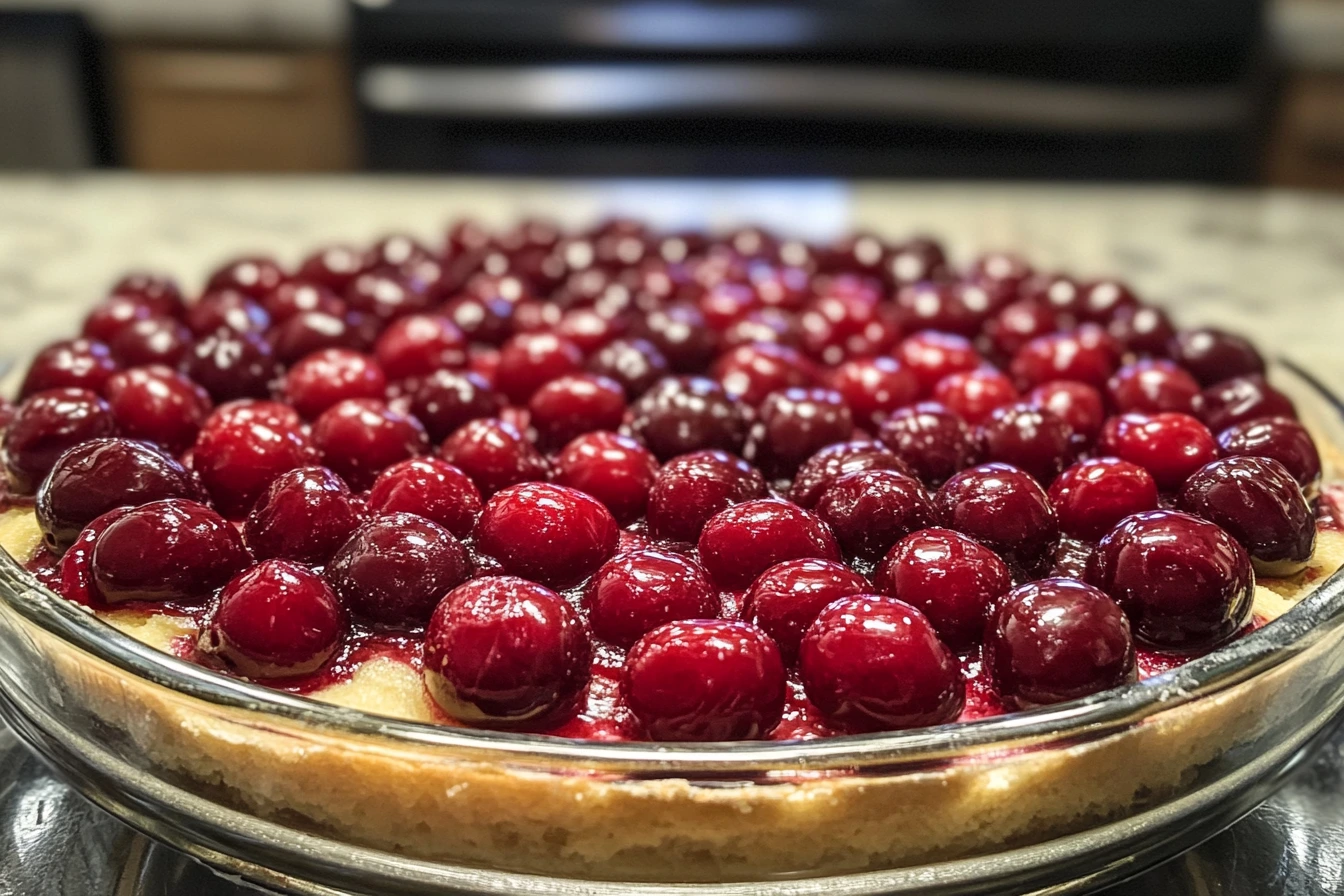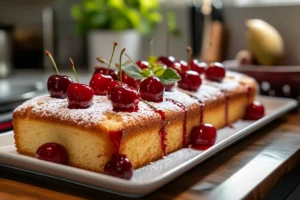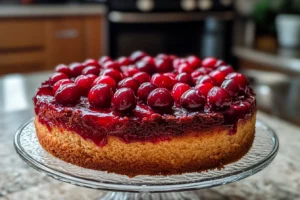Introduction to Cherry Cake Challenges
Cherry cake is a timeless favorite loved for its sweet, fruity flavor and soft, moist texture. However, one common challenge faced by bakers is figuring out how to keep cherries from sinking in cherry cake. This issue can not only ruin the cake’s appearance but also affect its texture and flavor balance.
For more baking tips and delicious cherry desserts, check out this Perfect Cherry Chip Cake Recipe.
Why Does This Happen?
- Cherries are heavier than the cake batter, causing them to drop during baking.
- The moisture content in cherries, especially in fresh and glacé varieties, makes them slippery.
- If the cake batter is too thin, it fails to hold the cherries evenly, leading to sinking.
Why Is It Important to Fix This?
For any baker, whether beginner or seasoned, achieving a perfectly baked cherry cake is incredibly satisfying. However, one of the biggest challenges is learning how to keep cherries from sinking in cherry cake. When cherries sink, it can affect both the cake’s texture and appearance. Fortunately, by following proven techniques, you can easily master how to keep cherries from sinking in cherry cake and create a visually stunning dessert every time.
Preventing cherries from sinking ensures:
- Even fruit distribution throughout the cake.
- A consistent flavor in every slice.
- A perfectly balanced, moist cherry cake that looks as good as it tastes.
Whether you’re using glacé cherries, fresh fruit, or frozen options, knowing how to keep cherries from sinking in cherry cake will elevate your baking skills. From prepping the cherries to adjusting batter consistency, the right steps can make all the difference.
By incorporating these simple yet effective techniques, you’ll never have to worry about sunken cherries again. Start practicing how to keep cherries from sinking in cherry cake, and enjoy the satisfaction of a perfectly baked, fruit-filled cake.
- Even fruit distribution throughout the cake.
- An aesthetically pleasing cake that looks as good as it tastes.
- Consistent flavor in every bite, providing a delightful experience for everyone.
The Art of Mastering Cherry Cakes
Perfecting cherry cakes takes both technique and attention to detail. For example:
- Choosing the right type of cherries makes a significant difference.
- Preparing the cherries properly before mixing them into the batter is essential.
Fortunately, there are proven techniques to solve this common problem. With a few simple adjustments, you can keep cherries evenly suspended in the cake batter. Whether you are baking for family, friends, or a special occasion, these tips will help you master cherry cake like a professional.
Why Do Cherries Sink in Cake Batter?
When baking cherry cake, it can be frustrating to see all the cherries sinking to the bottom. However, understanding the reasons behind this issue can help you solve it effectively.
The Science Behind Sinking Cherries
- Cherries are denser than cake batter. Since they are heavier, gravity pulls them downward as the cake bakes.
- The moisture content in cherries adds to their weight, making it harder for the batter to hold them in place.
The Role of Batter Consistency
- A batter that is too thin or runny cannot hold the cherries evenly. The cherries will sink quickly as the cake rises.
- Thicker batters, however, provide better support to suspend the fruit throughout the cake.
How Different Types of Cherries Behave
- Glacé Cherries: These are ideal for baking due to their reduced moisture content.
- Fresh Cherries: Fresh cherries are heavier and contain natural juices, which makes them more prone to sinking.
- Frozen or Canned Cherries: Though convenient, they retain water, which can thin out the batter.
Moisture Content and Cherry Sinking
- Excess moisture increases the chances of cherries sinking. Therefore, drying cherries thoroughly before use is crucial.
- For example, glacé cherries, when washed and dried, become lighter and easier to suspend in the batter.
Batter Preparation Is Key
The consistency of the batter plays a significant role. When combined with cherries, a well-prepared batter can ensure even distribution. Therefore, paying attention to the moisture balance of both the batter and cherries will help prevent this common issue.
Preparation Tips to Prevent Cherries from Sinking
Achieving an evenly distributed cherry cake requires careful preparation. Below are effective tips to ensure your cherries stay suspended throughout the batter.
Choose the Right Type of Cherries
- Opt for glacé cherries rather than fresh or canned cherries.
- Glacé cherries have lower moisture content, making them ideal for baking.
- If you prefer fresh cherries, remove excess moisture by drying them thoroughly.
Properly Prep the Cherries
- Quarter the cherries: Chopping cherries into smaller pieces reduces their weight, making them easier to suspend.
- Wash and dry: Rinse the cherries to remove any sticky residue or syrup. Then, pat them dry using a paper towel.
- Dust with flour: Lightly coat the cherries in flour before adding them to the batter. This simple step creates a grip that helps keep them from sinking.
How to Dust Cherries with Flour
- Place the cherries in a bowl.
- Add 1–2 tablespoons of flour (depending on the quantity).
- Toss the cherries until they are evenly coated.
- Shake off any excess flour before adding them to the cake mixture.
Adjust the Batter Consistency
- A slightly thicker batter helps suspend the cherries evenly.
- You can achieve this by using a batter with ground almonds or slightly reducing the liquid content.
Incorporate the Cherries Properly
- Mix cherries gently into a small portion of the batter first. This helps prevent them from sinking when added to the full mixture.
- Layer the cherries: Add a layer of batter, sprinkle some cherries, and repeat. This creates even fruit distribution throughout the cake.
Cherry Cake Recipe with Preventive Tips
This step-by-step recipe will guide you in baking a perfect cherry cake while ensuring the cherries remain suspended throughout.
Ingredients
- 200g glacé cherries (washed, quartered, and dried)
- 175g self-raising flour (plus extra for dusting cherries)
- 50g ground almonds (for added batter thickness)
- 175g softened butter
- 175g caster sugar
- 3 large eggs
- 1 tsp vanilla extract
- 2 tbsp milk
Instructions
Prepare the Cherries
- Rinse the glacé cherries under cold water.
- Pat them dry using paper towels to remove excess moisture.
- Quarter the cherries for even weight distribution.
- Dust the cherries lightly with flour to prevent sinking. Set aside.
Prepare the Batter
- Preheat the oven to 160°C (320°F). Grease and line a loaf tin with parchment paper.
- In a mixing bowl, cream the softened butter and caster sugar together until light and fluffy.
- Gradually beat in the eggs, one at a time. Add a tablespoon of flour with each egg to avoid curdling.
- Fold in the self-raising flour and ground almonds gently. Avoid overmixing to keep the batter light.
- Stir in the vanilla extract and milk to achieve the correct consistency. The batter should be thick enough to hold the cherries.
Incorporate the Cherries
- Take a small portion of the batter and mix it with the prepared cherries. This helps coat the fruit evenly.
- Pour half of the remaining batter into the loaf tin.
- Add half of the cherries evenly across the batter.
- Layer the rest of the batter on top, followed by the remaining cherries.
Bake the Cake
- Place the loaf tin in the preheated oven.
- Bake for 50–60 minutes or until a skewer inserted into the center comes out clean.
- If the top browns too quickly, cover it loosely with aluminum foil halfway through baking.
Cool and Serve
- Allow the cake to cool in the tin for 10 minutes before transferring it to a wire rack.
- Once cooled, slice and enjoy your perfectly baked cherry cake with evenly distributed cherries.
Tips for Success
- Always test the cake with a skewer to ensure it is baked through.
- Use room-temperature ingredients for a smooth batter consistency.
- Follow the preparation steps for cherries closely to avoid sinking issues.
By following this recipe and its preventive tips, you’ll create a cherry cake that is as beautiful as it is delicious. Enjoy your perfectly balanced, fruit-filled bake!
Alternative Methods to Stop Cherries from Sinking
While traditional methods like flour dusting are effective, there are other techniques to ensure cherries remain evenly distributed in your cake. If you’re looking for alternative solutions, the methods below will help you achieve a perfect bake.
Use Frozen Cherries Instead of Fresh Ones
- Frozen cherries tend to firm up in the batter as they bake, which helps prevent them from sinking.
- Before use, do not thaw the cherries. Add them straight to the batter to reduce excess moisture.
Cornstarch as an Alternative to Flour
- Instead of flour, try dusting cherries with cornstarch. It absorbs moisture efficiently and creates a similar “grip” to keep the fruit in place.
- Cornstarch works particularly well for fresh or canned cherries.
Mix Ground Nuts into the Batter
- Ingredients like ground almonds or walnuts add density to the cake batter, creating a structure that can hold the cherries.
- Ground nuts also enhance flavor, complementing the sweetness of cherries perfectly.
Layer the Batter and Cherries Strategically
- Pour half the batter into the cake tin, add a layer of cherries, then cover with the remaining batter.
- Repeat if necessary for multi-layered cakes. This technique keeps cherries evenly distributed.
Coat Cherries in Sugar Syrup
- For a creative twist, coat cherries lightly in a sugar syrup glaze. The syrup creates a sticky coating that helps cherries adhere to the batter, reducing sinking.
- Allow the syrup-coated cherries to dry slightly before incorporating them into the mixture.
By exploring these alternative techniques, you can experiment and find the best solution for your specific baking style. Whether you use frozen cherries, cornstarch, or ground nuts, these methods are simple and effective.
Troubleshooting Common Problems
Even with preparation and planning, issues can still arise when baking cherry cake. Below are solutions to common problems and tips to resolve them effectively.
Cherries Still Sinking Despite Preparation
- Solution: Check the batter consistency. If the batter is too thin, reduce the liquid content slightly in your recipe.
- Try increasing the amount of flour or ground nuts for added thickness.
Batter Is Too Wet
- Solution: Wet batter often results from overly moist cherries. Make sure to pat cherries dry thoroughly before adding them.
- If using frozen cherries, do not thaw them. Add directly to the batter to avoid releasing extra liquid.
Cherries Clump Together in One Spot
- Solution: Mix cherries with a small portion of the batter before incorporating them into the main mixture. This ensures even coating and distribution.
- Layer cherries strategically while adding batter to the pan.
Cake Over-Browns Before It’s Cooked
- Solution: Cover the cake with aluminum foil halfway through baking to prevent excessive browning while allowing the inside to bake through.
Cake Is Underbaked in the Center
- Solution: Always test the cake by inserting a skewer into the center. If it comes out wet, bake for an additional 5–10 minutes while monitoring closely.
Batter Curdles While Mixing
- Solution: Curdling happens when ingredients like eggs and butter are at different temperatures. Ensure all ingredients are at room temperature before mixing.
By addressing these common baking issues, you can confidently troubleshoot and improve your cherry cake with every bake.
FAQs How to Keep Cherries from Sinking
Below are answers to frequently asked questions related to keeping cherries suspended in cake batter.
Why do cherries sink to the bottom of cakes?
Cherries sink because they are denser than the cake batter. Moisture content and batter consistency also play a role. Without proper preparation, cherries naturally drop during baking.
Can I use fresh cherries instead of glacé cherries?
Yes, you can use fresh cherries, but they contain more moisture. To prevent sinking:
- Pit, quarter, and pat the cherries dry.
- Dust them lightly with flour or cornstarch before adding them to the batter.
What’s the best way to dry cherries for baking?
To dry cherries:
- Wash them thoroughly and pat them dry with paper towels.
- Allow them to air-dry for a few minutes before dusting them with flour.
Do frozen cherries work better than fresh cherries?
Frozen cherries can work well because they firm up as they bake. Add frozen cherries directly to the batter without thawing them to avoid excess moisture.
Why should I dust cherries with flour?
Dusting cherries with flour creates a grip between the cherries and the batter. This simple trick helps suspend the cherries evenly throughout the cake as it bakes.
How can I fix a cake if the cherries have already sunk?
If cherries have sunk:
- Use a sharp knife to slice the cake horizontally, removing the dense cherry layer.
- Add a layer of icing or cream to balance the flavor and presentation.
Can I use canned cherries for baking?
Canned cherries are an option, but they are often soaked in syrup, making them too wet. Drain and dry canned cherries thoroughly before incorporating them into the batter.
Does ground almond really help with cherry suspension?
Yes, ground almonds thicken the batter slightly, providing more support to suspend the cherries evenly. They also add a subtle nutty flavor to the cake.
Conclusion
Creating the perfect cherry cake can be a rewarding experience, especially when the cherries remain evenly suspended throughout the batter. By understanding why cherries sink and implementing proven solutions, such as dusting them with flour, prepping them properly, and adjusting the batter consistency, you can transform your baking results.
Additionally, exploring alternative methods, like using ground almonds or frozen cherries, provides more flexibility in achieving the desired outcome.
Remember, baking is both an art and a science. By paying attention to small details, troubleshooting common problems, and following the expert tips provided in this guide, you can confidently bake a cherry cake that is visually stunning and delicious in every bite.
So the next time you bake, don’t worry about sinking cherries apply these strategies, and your cake will be as perfect as you’ve envisioned. Happy baking!
For a deeper understanding of cherry-based desserts, you might enjoy exploring What Does Cherry Chip Cake Taste Like?.



